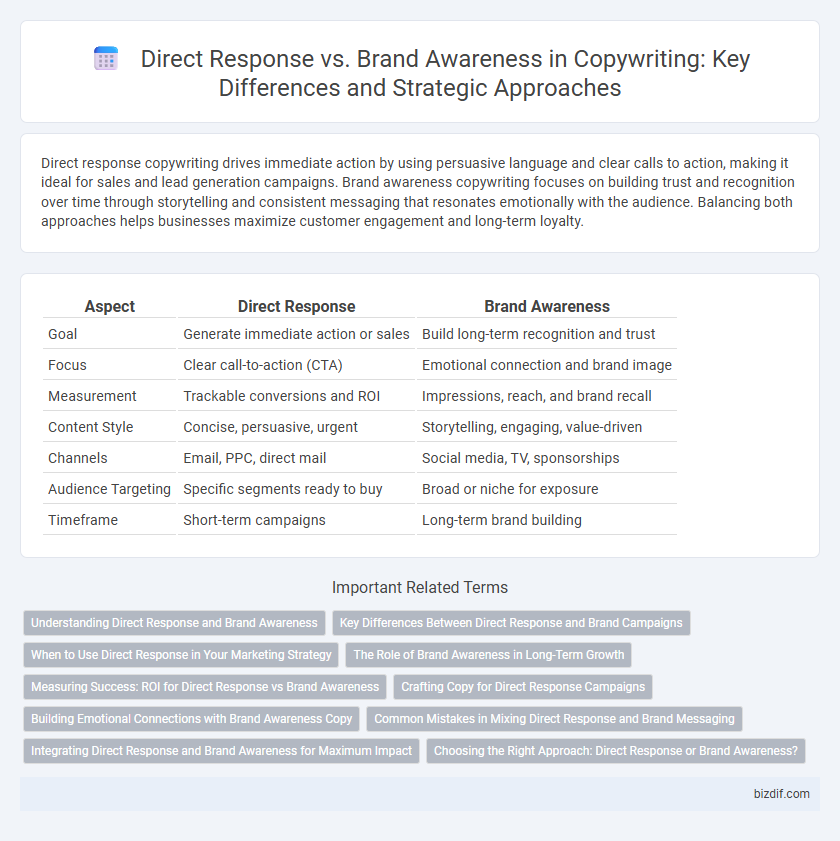Direct response copywriting drives immediate action by using persuasive language and clear calls to action, making it ideal for sales and lead generation campaigns. Brand awareness copywriting focuses on building trust and recognition over time through storytelling and consistent messaging that resonates emotionally with the audience. Balancing both approaches helps businesses maximize customer engagement and long-term loyalty.
Table of Comparison
| Aspect | Direct Response | Brand Awareness |
|---|---|---|
| Goal | Generate immediate action or sales | Build long-term recognition and trust |
| Focus | Clear call-to-action (CTA) | Emotional connection and brand image |
| Measurement | Trackable conversions and ROI | Impressions, reach, and brand recall |
| Content Style | Concise, persuasive, urgent | Storytelling, engaging, value-driven |
| Channels | Email, PPC, direct mail | Social media, TV, sponsorships |
| Audience Targeting | Specific segments ready to buy | Broad or niche for exposure |
| Timeframe | Short-term campaigns | Long-term brand building |
Understanding Direct Response and Brand Awareness
Direct response copywriting targets immediate customer actions through clear calls-to-action, measurable results, and persuasive messaging designed to generate leads or sales quickly. Brand awareness copywriting focuses on building long-term recognition and emotional connection by consistently communicating the brand's values, personality, and unique selling propositions. Understanding the distinction helps marketers allocate resources effectively, balancing quick conversions with sustained brand equity growth.
Key Differences Between Direct Response and Brand Campaigns
Direct response campaigns prioritize immediate actions by using clear calls-to-action and measurable metrics such as click-through and conversion rates, aiming to generate instant results. Brand awareness campaigns focus on building long-term recognition and emotional connections, measured through reach, impressions, and brand recall metrics. Key differences include the timeline of impact--short-term for direct response versus long-term for brand campaigns--and the primary goal of driving sales versus fostering brand loyalty.
When to Use Direct Response in Your Marketing Strategy
Direct response marketing excels when immediate action is the goal, making it ideal for time-sensitive offers, promotions, or product launches that require quick conversions. It is most effective in campaigns targeting highly segmented audiences with measurable outcomes such as clicks, sign-ups, or purchases. Utilizing direct response tactics allows marketers to optimize ROI through precise tracking and rapid feedback loops, crucial for performance-driven strategies.
The Role of Brand Awareness in Long-Term Growth
Brand awareness establishes emotional connections and trust, creating a loyal customer base that supports sustainable long-term growth. It increases top-of-mind recall, making future direct response campaigns more effective by reducing customer acquisition costs. Consistent brand visibility across multiple channels nurtures ongoing engagement and enhances lifetime customer value.
Measuring Success: ROI for Direct Response vs Brand Awareness
Measuring success in copywriting reveals clear distinctions between direct response and brand awareness campaigns, with ROI for direct response hinging on immediate conversions and trackable sales metrics. Brand awareness ROI, however, emphasizes long-term engagement, audience growth, and brand recall, often quantified through customer lifetime value and market share increases. These differing measurement frameworks require tailored analytical tools and KPIs aligned with each campaign's objectives.
Crafting Copy for Direct Response Campaigns
Crafting copy for direct response campaigns requires a clear, compelling call-to-action that drives immediate customer engagement and measurable results. Effective direct response copy leverages persuasive language, urgency, and targeted offers to prompt quick decisions and conversions. Emphasizing benefits and addressing pain points ensures the copy resonates with the audience and maximizes response rates.
Building Emotional Connections with Brand Awareness Copy
Brand awareness copy focuses on building emotional connections by crafting narratives that resonate deeply with the audience's values and aspirations, fostering trust and loyalty over time. Unlike direct response copy, which aims for immediate action, brand awareness emphasizes storytelling and consistent messaging to create a memorable brand identity. This approach enhances long-term customer engagement by aligning the brand's personality with the consumer's emotions and lifestyle.
Common Mistakes in Mixing Direct Response and Brand Messaging
Mixing direct response and brand awareness in copywriting often leads to diluted messaging that confuses the target audience, reducing campaign effectiveness. Common mistakes include unclear calls-to-action, inconsistent tone, and trying to achieve immediate sales while building long-term brand trust simultaneously. To optimize results, separate strategies should focus on either driving conversions with strong, urgent CTAs or cultivating brand identity through emotional storytelling.
Integrating Direct Response and Brand Awareness for Maximum Impact
Integrating direct response and brand awareness strategies enhances overall marketing effectiveness by combining immediate customer engagement with long-term brand loyalty. Direct response campaigns drive measurable actions such as clicks, leads, or purchases, while brand awareness efforts build recognition and trust that fuel future conversions. Seamlessly merging these approaches leverages targeted messaging and consistent branding to maximize ROI and strengthen market presence.
Choosing the Right Approach: Direct Response or Brand Awareness?
Choosing the right approach between direct response and brand awareness depends on your campaign goals and sales cycle. Direct response copywriting targets immediate actions with clear calls to action, maximizing conversion rates and measurable ROI. Brand awareness focuses on emotional storytelling and consistent messaging to build long-term customer loyalty and market presence.
Direct Response vs Brand Awareness Infographic

 bizdif.com
bizdif.com